Indian maritime history
This article may be in need of reorganization to comply with Wikipedia's layout guidelines. (August 2021) |
History of science and technology in the Indian subcontinent |
| By subject |
|---|
|
Indian maritime history begins during the 3rd millennium BCE when inhabitants of the
On orders of
National Maritime Day
5 April is celebrated as National Maritime Day in India. On this day in 1919, [citation needed] navigation history was created when SS Loyalty, the first ship of the Scindia Steam Navigation Company Ltd.,[citation needed] journeyed to the United Kingdom, a crucial step for India's shipping history when sea routes were controlled by the British.[citation needed]
Prehistory
The region around the Indus river began to show visible increase in both the length and the frequency of maritime voyages by 3000 BCE.[13] Optimum conditions for viable long-distance voyages existed in this region by 2900 BCE.[14] Mesopotamian inscriptions indicate that Indian traders from the Indus valley—carrying copper, hardwoods, ivory, pearls, carnelian, and gold—were active in Mesopotamia during the reign of Sargon of Akkad (c. 2300 BCE).[1] Gosch & Stearns write on the Indus Valley's pre-modern maritime travel:[15] Evidence exists that Harappans were bulk-shipping timber and special woods to Sumer on ships and luxury items such as lapis lazuli. The trade in lapis lazuli was carried out from northern Afghanistan over eastern Iran to Sumer but during the Mature Harappan period an Indus colony was established at Shortugai in Central Asia near the Badakshan mines and the lapis stones were brought overland to Lothal in Gujarat and shipped to Oman, Bahrain and Mesopotamia.
Archaeological research at sites in Mesopotamia, Bahrain, and Oman has led to the recovery of artefacts traceable to the Indus Valley civilisation, confirming the information on the inscriptions. Among the most important of these objects are stamp seals carved in soapstone, stone weights, and colourful carnelian beads....Most of the trade between Mesopotamia and the Indus Valley was indirect. Shippers from both regions converged in Persian Gulf ports, especially on the island of Bahrain (known as Dilmun to the Sumerians). Numerous small Indus-style artefacts have been recovered at locations on Bahrain and further down the coast of the Arabian Peninsula in Oman. Stamp seals produced in Bahrain have been found at sites in Mesopotamia and the Indus Valley, strengthening the likelihood that the island may have acted as a redistribution point for goods coming from Mesopotamia and the Indus area....There are hints from the digs at Ur, a major Sumerian city-state on the Euphrates, that some Indus Valley merchants and artisans (bead makers) may have established communities in Mesopotamia.
The world's first dock at
Excavations at

Early kingdoms

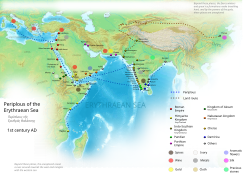
Eudaimon Arabia was called fortunate, being once a city, when, because ships neither came from India to Egypt nor did those from Egypt dare to go further but only came as far as this place, it received the cargoes from both, just as Alexandria receives goods brought from outside and from Egypt.
Tamil
The first clear mention of a navy occurs in the mythological epic Mahabharata.[27] Historically, however, the first attested attempt to organise a navy in India, as described by Megasthenes (c. 350—290 BCE), is attributed to Chandragupta Maurya (reign 322—298 BCE).[27] The Maurya Empire (322–185 BCE) navy continued till the times of emperor Ashoka (reign 273—32 BCE), who used it to send massive diplomatic missions to Greece, Syria, Egypt, Cyrene, Macedonia and Epirus.[27] Following nomadic interference in Siberia—one of the sources for India's bullion—India diverted its attention to the Malay Peninsula, which became its new source for gold and was soon exposed to the world via a series of maritime trade routes.[28] The period under the Mauryan empire also witnessed various other regions of the world engage increasingly in the Indian Ocean maritime voyages.[28]

According to the historian
The
Early Common Era—High Middle Ages
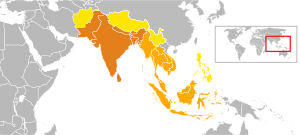
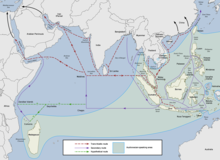
During this period,
Textiles from India were in demand in Egypt, East Africa, and the
Indian spice exports find mention in the works of Ibn Khurdadhbeh (850), al-Ghafiqi (1150 CE), Ishak bin Imaran (907) and Al Kalkashandi (14th century).
The
One of the
Kollam (also called Quilon or Desinganadu's) in coastal Kerala become operational in AD.825,[64] and has a high commercial reputation since the days of the Phoenicians and Romans,[65] The ruler of Kollam (who were vassals of Pandya dynasty who in turn later became vassals of Chola dynasty) also used to exchange the embassies with Chinese rulers and there was flourishing Chinese settlement at Kollam.[66] The Indian commercial connection with Southeast Asia proved vital to the merchants of Arabia and Persia between the 7th and 8th centuries CE,[9] and merchant Sulaiman of Siraf in Persia (9th Century) found Kollam to be the only port in India, touched by the huge Chinese junks, on his way from Carton of Persian Gulf.[66] Marco Polo, the great Venetian traveller, who was in Chinese service under Kublakhan in 1275, visited Kollam and other towns on the west coast, in his capacity as a Chinese mandarin.[66] Fed by the Chinese trade, port of Kollam was also mentioned by Ibn Battuta in the 14th century as one of the five Indian ports he had seen in the course of his travels during twenty-four years.[67]
Growth and development of agriculture in
The
The Trade with Malabar resulted in the drainage of Chinese gold in abundance that the Song dynasty (1127-1279) prohibited the use of gold, silver and bronze in foreign trade in 1219 and silk fabrics and porcelain was ordered to be bartered against foreign goods. Pepper, coconut, fish, betel nuts, etc. were exported from Malabar in exchange for gold, silver, colored satin, blue and white porcelain, musk, quicksilver and camphor from China
Late Middle Ages
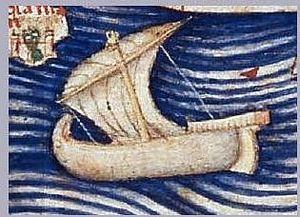
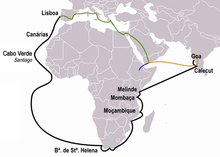
On the orders of
The first Dutch expedition left from
Early Modern Era
During the Mughal Empire, the province of Bengal Subah had a large shipbuilding industry. Economic historian Indrajit Ray estimates shipbuilding output of Bengal during the sixteenth and seventeenth centuries at 223,250 tons annually, compared with 23,061 tons produced in nineteen colonies in North America from 1769 to 1771.[73] He also assesses ship repairing as very advanced in Bengal.[73]
Bengali shipbuilding was advanced compared to European shipbuilding at the time. An important innovation in shipbuilding was the introduction of a
British Raj – Modern Period
The
In 1830 ships of the British East India Company were designated as the Indian navy. However, in 1863, it was disbanded when Britain's Royal Navy took control of the Indian Ocean. About thirty years later, the few small Indian naval units were called the Royal Indian Marine (RIM). In the wake of World War I, Britain, exhausted in manpower and resources, opted for expansion of the RIM. Consequently, on 2 October 1934, the RIM was reincarnated as the Royal Indian Navy (RIN).

The Indian rulers weakened with the advent of the European powers.[43] Shipbuilders, however, continued to build ships capable of carrying 800 to 1,000 tons.[43] The shipbuilders at the Bombay Dockyard built ships like HMS Hindostan and HMS Ceylon, inducted into the Royal Navy.[43] The historical ships made by Indian shipbuilders included HMS Asia (commanded by Edward Codrington during the Battle of Navarino in 1827), the frigate HMS Cornwallis (onboard which the Treaty of Nanking was signed in 1842), and HMS Minden (on which "The Star-Spangled Banner" was composed by Francis Scott Key).[43] David Arnold examines the role of Indian shipbuilders during the British Raj:[76]
Shipbuilding was a well-established craft at numerous points along the Indian coastline long before the arrival of the Europeans and was a significant factor in the high level of Indian maritime activity in the Indian Ocean region....As with cotton textiles, European trade was initially a stimulus to Indian shipbuilding: vessels built in ports like Masulipatam and Surat from Indian hardwoods by local craftsmen were cheaper and tougher than their European counterparts.
Between the seventeenth and early nineteenth centuries Indian shipyards produced a series of vessels incorporating these hybrid features. A large proportion of them were built in Bombay, where the Company had established a small shipyard. In 1736 Parsi carpenters were brought in from Surat to work there and, when their European supervisor died, one of the carpenters, Lowji Nuserwanji Wadia, was appointed Master Builder in his place.
Wadia oversaw the construction of thirty-five ships, twenty-one of them for the Company. Following his death in 1774, his sons took charge of the shipyard and between them built a further thirty ships over the next sixteen years. The Britannia, a ship of 749 tons launched in 1778, so impressed the Court of Directors when it reached Britain that several new ships were commissioned from Bombay, some of which later passed into the hands of the Royal Navy. In all, between 1736 and 1821, 159 ships of over 100 tons were built at Bombay, including 15 of over 1,000 tons. Ships constructed at Bombay in its heyday were said to be 'vastly superior to anything built anywhere else in the world'.
Contemporary Era (1947–present)
Military
In 1947, the
India's Coast Guard Act was passed in August 1978.
As a result of the growing strategic ties with the western world the Indian navy has conducted joint exercises with its western counterparts, including the
Civil
This section needs to be updated. (September 2016) |
Since the start of the new millennium international trade by and through India has grown manifold . The following table gives the detailed data about the major ports of India for the financial year 2005–06 and percentage growth over 2004–05 (Source: Indian Ports Association):
| Name | Cargo Handled (06-07) '000 tonnes | % Increase (over 05–06) | Vessel Traffic (05-06) | % Increase (over 04–05) | Container Traffic (05-06) '000 TEUs | % Increase (over 04–05) |
|---|---|---|---|---|---|---|
Kolkata (Kolkata Dock System & Haldia Dock Complex) |
55,050 | 3.59% | 2,853 | 07.50% | 313 | 09.06% |
Paradip |
38,517 | 16.33% | 1,330 | 10.01% | 3 | 50.00% |
| Visakhapatnam | 56,386 | 1.05% | 2,109 | 14.43% | 47 | 04.44% |
| Chennai | 53,798 | 13.05% | 1,857 | 11.26% | 735 | 19.12% |
| Tuticorin | 18,001 | 05.03% | 1,576 | 06.56% | 321 | 04.56% |
| Cochin | 15,314 | 10.28% | 1,225 | 09.38% | 203 | 09.73% |
| New Mangalore Port | 32,042 | -06.99% | 1,087 | 01.87% | 10 | 11.11% |
| Mormugao | 34,241 | 08.06% | 642 | -03.31% | 9 | -10.00% |
| Mumbai | 52,364 | 18.50% | 2,153 | 14.34% | 159 | -27.40% |
| J.N.P.T, Navi Mumbai | 44,818 | 18.45% | 2,395 | 03.06% | 2,267 | -04.39% |
| Ennore | 10,714 | 16.86% | 173 | 01.17% | ||
| Kandla | 52,982 | 15.41% | 2,124 | 09.48% | 148 | -18.23% |
| All Indian Ports | 463,843 | 9.51% | 19,796 | 08.64% | 4,744 | 12.07% |
See also
- Spread of Indian influence through maritime routes
- Greater India
- Indosphere
- Non-resident Indian and Overseas Citizen of India
- Buddhism in Southeast Asia
- Hinduism in Southeast Asia
- History of Indian influence on Southeast Asia
- Indianization of Southeast Asia
- Tamil loanwords in Biblical Hebrew
- Trading routes
Notes
- ^ a b Gosch & Stearns, 12
- ^ Young, 20
- ^ Ball, 131
- ^ Ball, 137
- ^ a b c d e Lach, 18
- ^ a b c Curtin, 100
- ^ a b Holl, 9
- ^ a b Lindsay, 101
- ^ a b c Donkin, 59
- S2CID 87793562.
- doi:10.1038/493274c.
- ^ a b c d "Gama, Vasco da". The Columbia Encyclopedia, Sixth Edition. Columbia University Press.
- ^ Gosch & Stearns, 7
- ^ Gosch & Stearns, 9
- ^ Gosch & Stearns, 12–13
- ISBN 978-0-19-522243-2.
The molded terra-cotta tablet shows a flat-bottomed Indus boat with a central cabin. Branches tied to the roof may have been used for protection from bad luck, and travelers took a pet bird along to help them guide them to land.
- ^ a b c Rao, 27–28
- ^ a b c Rao, 28–29
- ^ a b Sushanta Ku. Patra & Benudhar Patra. "ARCHAEOLOGY AND THE MARITIME HISTORY OF ANCIENT ORISSA" (PDF). OHRJ, Vol. XLVII, No. 2. Retrieved 16 November 2010.
- ^ Sila Tripati. "Early Maritime Activities of Orissa on the East Coast of India: Linkages in Trade and Cultural Developments" (PDF). Marine Archaeology Centre, National Institute of Oceanography, Dona Paula, Goa. Retrieved 17 November 2010.
- ISBN 0-415-24219-3, page 20
- ^ Manichaeism worshipped Jesus, Buddha. This Silk Road religion’s strength became its weakness, The Print, 14 dec 2023.
- ^ "South Indians in Roman Egypt?". www.frontline.in. 23 April 2010. Retrieved 26 February 2018.
- ^ a b Sircar, 330
- ^ Sircar, 327
- ^ a b Young, 19
- ^ a b c Chakravarti (1930)
- ^ a b c Shaffer, 309
- Ptolemies, only a very few ventured to undertake the voyage and to carry on traffic in Indian merchandise." —"The Geography of Strabo published in Vol. I of the Loeb Classical Library edition, 1917".
- ^ Lach, 13
- ^ a b c Halsall, Paul. "Ancient History Sourcebook: The Periplus of the Erythraean Sea: Travel and Trade in the Indian Ocean by a Merchant of the First Century". Fordham University.
- OCLC 57054139.
- ISBN 9783319338224.
- ^ Donkin, 67
- ^ Donkin, 69
- ^ Xinru, Liu,The Silk Road in World History (New York: Oxford University Press, 2010), 21.
- ^ Foltz, Richard C. (1999). Religions of the Silk Road: Overland Trade and Cultural Exchange from Antiquity to the Fifteenth Century. New York: St Martin's Press. p. 45.
- ^ "Maritime Silk Road". SEAArch.
- ^ a b c d Guan, Kwa Chong (2016). "The Maritime Silk Road: History of an Idea" (PDF). NSC Working Paper (23): 1–30.
- S2CID 140665305.
- ISBN 9781588395245.
- ISBN 978-0415100540.
- ^ "Bali Yatra". Orissa Tourism. Archived from the original on 21 July 2011. Retrieved 16 November 2010.
- ^ Donkin, 64
- ^ a b c Donkin, 92
- ^ Donkin, 65
- ^ a b Donkin, 91–92
- ^ Nilakanta Sastri, A History of South India, 5
- ^ Kulke & Rothermund, 115
- ^ Rajendra Chola I completed the conquest of the island of Sri Lanka and captured the Sinhala king Mahinda V. Nilakanta Sastri, The CōĻas pp 194–210.
- ^ Majumdar, 407
- ^ The kadaram campaign is first mentioned in Rajendra's inscriptions dating from his 14th year. The name of the Srivijaya king was Sangrama Vijayatungavarman—Nilakanta Sastri, The CōĻas, 211–220.
- ^
Shaffer, Lynda Noreen (2001). "Southernization". In ISBN 9781566398329. Retrieved 24 December 2013.
The term 'southernization' [...] is used [...] to refer to a multifaceted process that began in Southern Asia and spread from there [...]. The process included [...] many interrelated strands of development[:] [...] the metallurgical, the medical, [...] the literary [...] the development of mathematics; the production and marketing of subtropical or tropical spices; the pioneering of new trade routes; the cultivation, processing, and marketing of southern crops such as sugar and cotton; and the development of various related technologies. [...] Southernization was well under way in Southern Asia by the fifth century C.E.
- ^ Kulke & Rothermund, 116–117.
- ^ Kulke & Rothermund, 12
- ^ Kulke & Rothermund, 118
- ^ Kulke & Rothermund, 124
- ^ Tripathi, 465
- ^ Tripathi, 477
- ^ Nilakanta Sastri, The CōĻas, 604
- ISBN 9780199271863.
- ^ a b c See A History of South India – pp 146 – 147
- ISBN 9781136639791. Retrieved 23 November 2016.
- ^ Sastri, K. A. Nilakanta (1958) [1935]. History of South India (2nd ed.). Oxford University Press.
- ^ a b c "Short History of Kollam". Archived from the original on 18 May 2011. Retrieved 20 October 2014.
- ^ Kollam - Mathrubhumi Archived 9 October 2014 at the Wayback Machine
- ^ a b Chaudhuri, 223
- ^ Corn 1999, pp 68-. "If the Portuguese had wrested the spice trade from the Arabs in those distant lands, then why shouldn't a people enslaved by a false doctrine be likewise freed? This rhetorical question became for Xavier his ultimate concern. It was Portugal's supremacy on the seas and in the spice trade that allowed it to flourish."
- ^ a b c d Donkin, 169
- ^ a b Sardesai, 53–56, Shivaji Bhonsle and Heirs
- ^ Sardesai, 293–296, Peshwai and Pentarchy
- ^ ISBN 978-1-136-82552-1.
- ^ "Technological Dynamism in a Stagnant Sector: Safety at Sea during the Early Industrial Revolution" (PDF).
- ^ a b c d e f g h i j k Kadian (2006)
- ^ Arnold, 101–102
- ^ The navy was used in national integration by ferrying troops and securing the coast during the Junagadh state operations—Rajesh Kadian (2006).
- ^ the Indian navy, among other actions, sank the Portuguese frigate Afonso de Albuquerque—Rajesh Kadian (2006).
- frogmen sank or damaged over 100,000 tons of shipping in four months and disrupted ports and inland waterways, the lifeline of the country. In December, after the war formally started, an imaginative, daring raid by Osa missile boats on Karachiharbor sank two warships, damaged others, and ignited oil storage facilities. The Indian armed forces conducted amphibious landings for the first time toward the end of the war—Rajesh Kadian (2006).
Bibliography
- Radhakumud Mookerji (1912). Indian Shipping - A history of the sea-borne trade and maritime activity of the Indians from the earliest times. Longmans, Green and Co., Bombay.
- Mehta, Asoka (1940). Indian Shipping: A case study of the working of Imperialism. N.T.Shroff, Bombay.
References
- Arnold, David (2004), ISBN 0-521-56319-4.
- Ball, Warwick (2000), Rome in the East: The Transformation of an Empire, Routledge, ISBN 0-415-11376-8.
- Chakravarti, P. C. (1930), "Naval Warfare in ancient India", The Indian Historical Quarterly, 4 (4): 645–664.
- ISBN 0-521-28542-9.
- Corn, Charles (1999) [First published 1998], The Scents of Eden: A History of the Spice Trade, Kodansha, ISBN 1-56836-249-8.
- Curtin, Philip DeArmond etc. (1984), Cross-Cultural Trade in World History, Cambridge University Press, ISBN 0-521-26931-8.
- Donkin, Robin A. (2003), Between East and West: The Moluccas and the Traffic in Spices Up to the Arrival of Europeans, Diane Publishing Company, ISBN 0-87169-248-1.
- Gosch, Stephen S. & Stearns, Peter N. (2007), Premodern Travel in World History, Taylor & Francis, ISBN 0-203-92695-1.
- Hermann & Rothermund [2000] (2001), A History of India, Routledge, ISBN 0-415-32920-5.
- Holl, Augustin F. C. (2003), Ethnoarchaeology of Shuwa-Arab Settlements, Lexington Books, ISBN 0-7391-0407-1.
- Kadian, Rajesh (2006), "Armed Forces", Encyclopedia of India (vol. 1) edited by Stanley Wolpet, pp. 47–55.
- Kulke & Rothermund [2000] (2001), A History of India, Routledge, ISBN 0-415-32920-5.
- Lach, Donald Frederick (1994), Asia in the Making of Europe: The Century of Discovery, University of Chicago Press, ISBN 0-226-46731-7.
- Lindsay, W.S. (2006), History of Merchant Shipping and Ancient Commerce, Adamant Media Corporation, ISBN 0-543-94253-8.
- Majumdar, R.C. (1987), Ancient India, Motilal Banarsidass Publications, ISBN 81-208-0436-8.
- Nilakanta Sastri, K.A [1935] (1984), The CōĻas, University of Madras.
- Nilakanta Sastri, K.A [1955] (2002), A History of South India, Oxford University Press.
- K.M. Panikkar, 1945: India and the Indian Ocean: an essay on the influence of sea power on Indian history
- Rao, S. R. (1985), Lothal, Archaeological Survey of India.
- Rao, S. R. The Lost City of Dvaraka, National Institute of Oceanography, ISBN 81-86471-48-0(1999)
- Rao, S. R. Marine Archaeology in India, Delhi: Publications Division, ISBN 81-230-0785-X(2001)
- Sardesai, D.R. (2006), "Peshwai and Pentarchy", Encyclopedia of India (vol. 3) edited by Stanley Wolpet, pp. 293–296.
- Sardesai, D.R. (2006), "Shivaji Bhonsle and Heirs", Encyclopedia of India (vol. 4) edited by Stanley Wolpet, pp. 53–56.
- Shaffer, Lynda N. (2001), "Southernization", Agricultural and Pastoral Societies in Ancient and Classical History edited by Michael Adas, Temple University Press, ISBN 1-56639-832-0.
- Sircar, D.C. (1990), Studies in the Geography of Ancient and Medieval India, Motilal Banarsidass Publishers, ISBN 81-208-0690-5.
- Tripathi, Rama Sankar (1967), History of Ancient India, Motilal Banarsidass Publications, ISBN 81-208-0018-4.
- Young, Gary Keith (2001), Rome's Eastern Trade: International Commerce and Imperial Policy, 31 BC-AD 305, Routledge, ISBN 0-415-24219-3.
- Medieval Kerala's Maritime trade history with Arabs and Chinese https://www.tyndisheritage.com/the-amazing-stories-of-kerala-maritime-history
